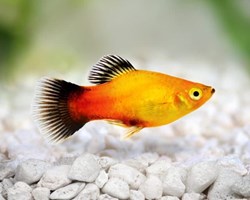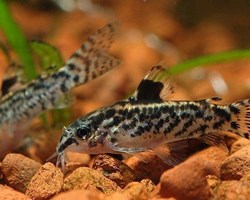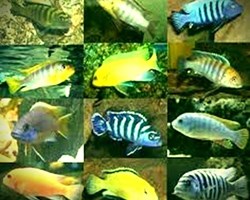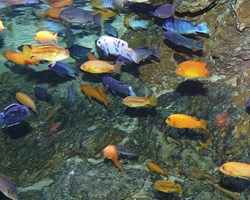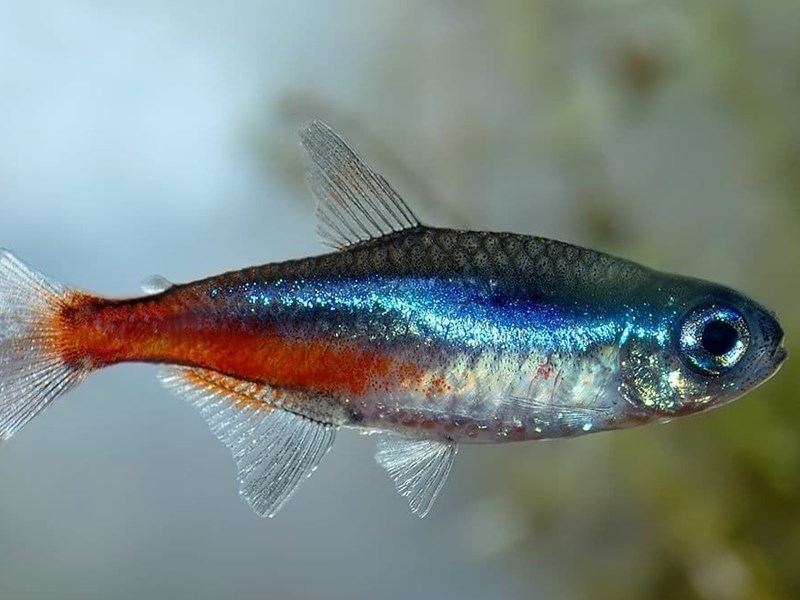
NEON TETRA DESCRIPTION:
Scientific name: Paracheirodon innesi, Hyphessobrycon innesi.
Common name: Neon fish, neon tetra.
Aquarium size: 60 liters.
Temperament: Calm.
Temperature: Between 21º and 28ºC.
pH: Between 4 and 7.5.
Diet: Omnivores.
Length: 4 cm.
The neon tetra is a fish that has been gaining popularity due to its resistance to parameters (despite being sensitive to the white point), but its blue, silver and red colors make it a tremendously attractive fish for the hobbyist.
The Neon fish, Neon tetra or Neon Innesi, is a warm and fresh water fish of the characin family, they are related to the famous piranhas, and with the also known Tetra Cardinal or neon Cardinal.
Not to be confused with the Chinese neon fish, which is from the cyprinid family, and is a cold water neon fish.
It is a fish that is not too easy to reproduce in the aquarium, although not impossible.
It is a very popular fish since professionals have managed to overcome the problem of reproduction in captivity and many of these fish are produced, greatly reducing the price of neon fish.
A fish that adapts well to living with other species, is not very demanding in terms of water quality and is very resistant, which makes it a suitable variety of fish for anyone who wants to start in the world of aquariums.
The neon fish or neon tetra, is a fairly small fish, usually measuring about 4 centimeters.
They have an elongated shape, with a rounded nose.
Its coloration is formed by an intense blue or greenish blue lateral stripe, with a red spot on the ventral part of the fish.
This strip is less noticeable in the black waters, it seems that it would be a natural protection against predators.
It is known that neon fish can change the intensity of their coloration, becoming lighter in conditions of a lighter substrate or background, and more opaque and with a more violet lateral stripe during the night.
It is supposed to be a natural response, intended to make them less visible to their predators.
There is no obvious sexual dimorphism, except that females are usually somewhat rounder and larger than males.
It is quite difficult to tell the difference between one and the other.
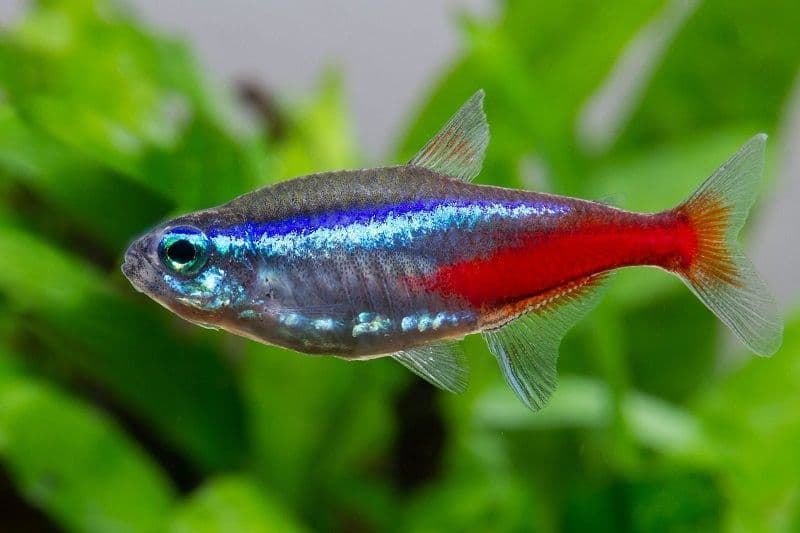
TO KNOW HOW TO TAKE CARE OF THE NEON TETRA, YOU NEED TO KNOW WHERE THEY COME FROM:
Although the origin of the neon fish is not very clear, it has been proven that geographically there are several areas of location, one would be around Leticia, Colombia and Brazil.
A second area, in which populations of Paracheirodon innesi have also been found, is a few hundred kilometers to the east, in the Amazon, Brazil and the Purus River, a tributary of the Amazon at the mouth of Codajás.
Additional populations have also been sighted in western Brazil, eastern Peru, and southeastern Colombia.
Its natural habitat is the minor currents of main river channels.
They are acidic and soft waters, usually stained brown, due to the presence of decomposing organic matter.
But this is not always the case, because some populations live in transparent waters.
THE BEST AQUARIUM CONDITIONS FOR THE NEON TETRA:
The neon fish does not need a very large aquarium, with 50 or 60 liters is enough.
The water must be kept at a temperature between 21º and 28ºC, with a pH between 4 and 7.5, the hardness can be set at 18-215 ppm.
The decoration of the aquarium should comprise a dark sandy substrate, in which some roots and floating wood branches should be included.
It is not necessary to add natural peat, which is more difficult to maintain and will dirty the aquarium.
Some dry leaves or floating plants could be added to the aquarium, which will provide a greater sense of naturalness.
Although we place plants and trunks, among which they can seek refuge, it is convenient to leave the center of the aquarium clear, so that they find free spaces in which to swim.
They are more comfortable in dim lighting.
The plant species that we are going to include in the aquarium must be able to withstand this situation.
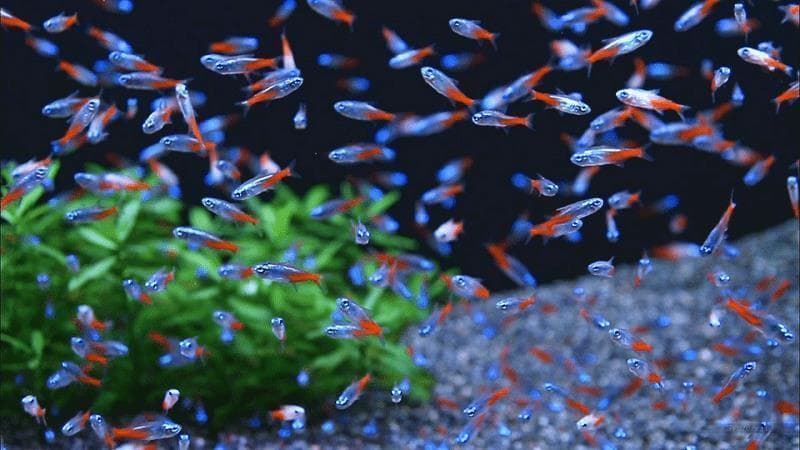
THE NUTRITION OF THE NEON TETRA FISH:
It is recommended to give them small amounts of food, spaced in three daily meals.
They are omnivorous fish, which can eat dry food without problems.
The diet should be supplemented with Daphnia, Moina or tubifex larvae; mosquito larvae.
We can complement your diet with lettuce leaves and other vegetables.
It is important that the size of the pieces is small, we are dealing with a very small fish, the size of the food has to be consistent.
TO KNOW MORE ABOUT NEON TETRA YOU NEED TO KNOW ABOUT ITS BEHAVIOR AND COMPATIBILITY:
The neon tetra is a sociable and gregarious fish, so that they are in the best conditions, it is convenient to add between 8 and 10 fish, including males and females. The feeling will be more natural.
It can be combined with other characins of similar size or smaller, it will share its space well with non-predatory cichlids or catorish loricariids.
Unrestricted Neon Tetra Compatible Fish:
- Botia Clown.
- Mosquito fish.
- Otocinclus.
- Drunken Fish.
- Rainbow.
- Cherry Barbel.
- Corydoras.
- Ramirezi.
- Rasbora Galaxy.
- Ancistrus.
- Nun fish.
- Zebra fish.
- female betta.
- Harlequin fish.
- Telescope fish.
- Apple Snail.
- Pearl Gourami.
- Kribensis cichlid.
- Ax Fish.
- Chinese neon.
- Tiger Barb.
- Molly fish.
- Comet Goldfish.
- Platy fish.
- Bubble eyed fish.
Fish compatible with restrictions:
- Scalar Fish.
- Koi carp.
- Paradise fish.
- Killi fish.
- Discus fish.
- Silver Dollar Fish.
- Guppies.
- Guppy Endler.
THE REPRODUCTION OF THE NEON TETRA:
Although raising neons is not easy, it is possible, provided that certain conditions are recreated:
- A breeding tank should be set up, which should be dimly lit and contain fine-leaved plants, to offer them a place to lay their eggs.
- It is convenient to cover the bottom of the aquarium with some type of mesh, which allows the eggs to pass through, but which prevents the adult fish from having access to them, so that they cannot eat them.
- The water conditions must be modified. We should look for a temperature of about 27ºC, with a pH of 5.5-6.5.
- For reproduction, we can place a group of males and females, although better results are obtained if we can put a male neon fish and a female neon fish.
- When we believe that the females are full of eggs (pregnant neon fish), we transfer the male to the tank.
- We will look for the fattest and that has the most vivid colors. It must be done at night.
- They should spawn the next morning, and see eggs in two days. Remove the adult tetra once we have evidence of spawning.
- The eggs hatch between 24 and 36 hours after laying, and we can see fry after 3 or 4 days.
- Fingerlings are very sensitive to light, if possible keep the tank in the dark.
DISEASES OF NEON TETRA FISH:
Neon fish are prone to white spot disease.
This disease is contracted by fish through the mouth, they excavate the walls of the intestine and subsequently enter the muscles of the fish, producing cysts that degenerate the muscle tissue, and which we later observe as white dots.
The mortality rate is very high.
The best thing in these cases is to eliminate the affected fish, so that it does not infect the rest.
If we observe that any specimen shows signs of restlessness, separates from the rest or as a climax, we observe the white spots, we will separate it from the rest in another aquarium.
There is another common disease, called "false neon disease", which can be successfully treated if antibacterial products are used.
For this reason, it is always worthwhile to isolate the fish that we observe is sick, and treat it with the help of a professional.
Other articles that may interest you:
- Diseases of the Drunken Fish.
- Varieties of the Pez Borrachito.
- The Lemon Tetra is one of the most beautiful fish for a community aquarium.
- Chinese neon or White Cloud Mountain fish, named for its place of origin in southern China.
- Black neon tetra.
- drunk fish.
- The best care of the Tetra nun.
- What do you need to have your first aquarium.
- Aquarium maintenance.
- The best tropical freshwater fish recommended for beginners.
- The best aquarium plants for beginners that you should know.
- The best plants for cold water aquariums.
- The best groundcover plants for your aquarium.
- The best substrates for a planted aquarium.
- Aquascaping for beginners.

